References >> Gateway Cloning
Gateway® CloningIntroduction to Gateway® Cloning
Gateway® Cloning is a universal cloning technique developed by Invitrogen life technologies. Gateway® Cloning Technique allows transfer of DNA fragments between different cloning vectors while maintaining the reading frame. It has effectively replaced the use of restriction endonucleases and ligases. Using Gateway®, one can clone/sub clone DNA segments for functional analysis.
Gateway® Cloning Mechanism
(a)The BP Reaction (PCR fragment
+ Donor vector = Entry Clone)
The BP Reaction is a recombination reaction
which is explained in the following lines.
For the reaction to take place, the gene of
interest is amplified with the help of an
attB tagged primer pair. The donor vector
includes attP sites. The PCR product that
includes the attB sites combines with the
donor vector that includes the attP sites
resulting in the formation of an entry clone.
This integration reaction between the attB
and the attP sites forms the basis of this
reaction. The resulting entry clone contains
the gene of interest flanked by attL sites.
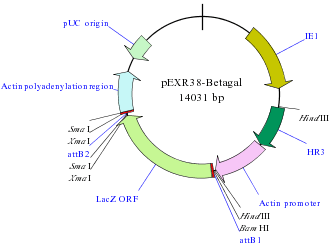 Expression Clone |
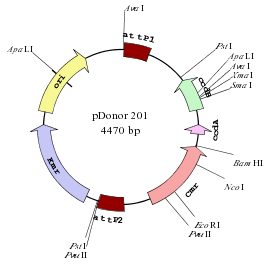 Donor Vector |
 |
|
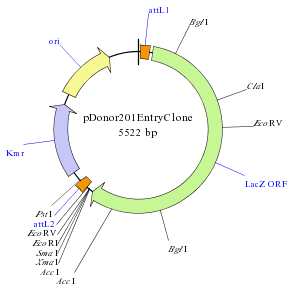 Entry Clone |
|
Graphical Illustration of BP Reaction in Gateway® Cloning |
|
(b)The LR reaction (Entry Clone + Destination Vector = Expression Clone)
The LR Reaction, again is a recombination reaction between attL and attR sites. The reaction generates an expression clone and is catalyzed by recombinant proteins. The entry clone generated from the BP reaction includes the attL sites. The Destination vector is designed to include the attR sites. The LR reaction is carried out to transfer the sequence of interest to one or more destination vectors in simultaneous reactions, making the technology high throughput. The entry clone is mixed with the appropriate Gateway® vector and Gateway® Clonase enzyme. Recombination between these sites generates two molecules. One molecule contains the DNA segment of interest, the other molecule is a by-product.
 Entry Clone |
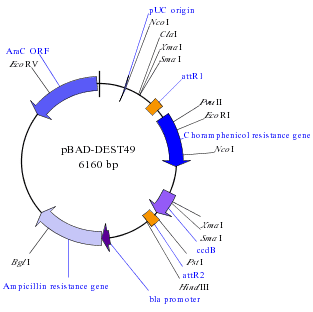 Destination Vector |
 |
|
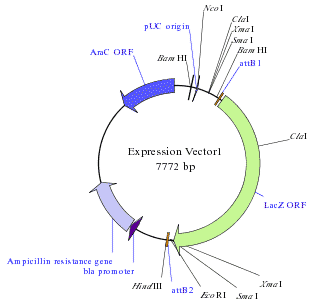 Expression Vector |
|
Graphical Illustration of LR Reaction in Gateway® Cloning |
|
Applications
- Allows subcloning from one vector backbone to another.
- Every subcloning reaction maintains the appropriate reading frame.
- Subcloning process is fast and facilitates reaction automation.
- Supports site specific recombination.
- Multiple genes can be transferred to one or more vectors in one experiment.
| In-Silico Gateway® Cloning with SimVector | |
| SimVector is a comprehensive DNA sequence analysis tool that allows you to plan and design cloning experiments. | |
Using SimVector you can perform both the BP and the LR reactions that constitute Gateway® Cloning. The donor vector and the expression vector are required for the BP reaction and for generating an entry clone. An entry vector and a destination vector are required for the LR reaction and for generating an expression vector.
Other Techniques Performed by SimVector
TA Cloning: SimVector makes it easy to design TA cloning experiments. The TA cloning wizard accepts both commercial T-vectors or restriction designed T-vectors and combines them with the modified PCR product. You can then generate a highly accurate recombinant DNA plasmid map.
Restriction Cloning: This cloning technique requires restriction enzymes to cut the vector molecule and the molecule to be cloned. SimVector performs restriction enzyme analysis and allows you to filter, annotate and map the restriction enzymes on the desired sequences.
Restriction Enzyme Analysis
SimVector identifies restriction enzyme recognition sites in DNA sequences for restriction site mapping. A comprehensive database of over 1000 restriction enzymes is used for the restriction analysis. Two modes of enzyme filtering are provided to specify the parameters for restriction analysis. Enzyme filtering enables you to set the enzyme criteria to match your experimental requirements. For convenience, enzyme sets from more than 20 commercial providers are included.
Draw Accurate Plasmid Maps
SimVector is an exceptional tool to draw publication quality plasmid maps. The graphics can then be enhanced with patterns, styles, lines, and colors. SimVector generates plasmid map images in vector graphic format for Adobe Illustrator 10 and Microsoft PowerPoint 2002.



